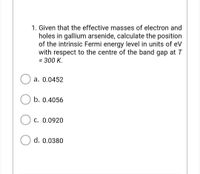
Introductory Circuit Analysis (13th Edition)
13th Edition
ISBN: 9780133923605
Author: Robert L. Boylestad
Publisher: PEARSON
expand_more
expand_more
format_list_bulleted
Question
thumb_up100%

Transcribed Image Text:1. Given that the effective masses of electron and
holes in gallium arsenide, calculate the position
of the intrinsic Fermi energy level in units of eV
with respect to the centre of the band gap at T
= 300 K.
a. 0.0452
b. 0.4056
c. 0.0920
d. 0.0380
Expert Solution
This question has been solved!
Explore an expertly crafted, step-by-step solution for a thorough understanding of key concepts.
Step by stepSolved in 2 steps with 3 images

Knowledge Booster
Similar questions
- Figure shows the parabolic E versus k relationship in the conduction band for an electron in two particular semiconductor materials. Determine the effective mass (in unit of the free electron mass) of the two electrons. E (eV)4 0.5 0.05 A -0.08 0.08 k (Å-1)arrow_forward4. The electron concentration in pure silicon is 1.5×1016 m-3 at 300°K. The silicon was doped with 1022m-3 donor atoms. Find the electron and hole densities after doping and calculate the position of the new Fermi level with to the initial position?arrow_forwardConsider a material where the probability of a hole occupying a state in the middle of the valence band at room temperature is 0.7, what type of material is this? O An insulator O A conductor There is no enough information to determine the nature of the material O A semiconductorarrow_forward
- A silicon semiconductor material at T = 300 K is doped with arsenic atoms to a concentration of 2*10 ^15 cm -3 and with boron atoms to a concentration of 1.2*10 ^15 cm -3 . (a) Is the material n type or p type? (b) Determine n0 and p0 . (c) Additional boron atoms are to be added such that the hole concentration is 4*10 15 cm -3 . What concentration of boron atoms must be added and what is the new value of n0? Please answer in typing formatarrow_forwardA diode with n =1.6 conducts 45 mA at 0.75V at room temperature. Find the saturation current Is at room temperature (using the exponential model).arrow_forwardmodels Diodes-Piece-wise Problem #1 In the circuit shown below, the voltage source Vin is given by the sketch. Assuming an ideal diode, sketch the waveform resulting at Vout. Use the axis at the bottom to help you sketch the voltage output. 10Ω Vin +7V -7V + Vin Vin AA 1 3 4 5 1 2 D 3 5 V 4 + Vout 5 6 ➡t (ms) +++t (ms) 6arrow_forward
- Assume that the mobility of electrons in silicon at T = 300 K is un 1300 cm²/V-s. Also assume that the mobility is mainly limited by lattice scattering. Determine the electron mobility(cm²/V-s) at T = 400 K. 844 484 864 854arrow_forwardCalculate the thermal-equilibrium hole concentration (cm-³) in Silicon at T=375 k. Assume the Fermi energy is 0.25 eV above the valence band energy. The value of N,=1.04x1019 cm-3 at T=300K. 6.15x10^10 3.33x10^15 6.13x10^15 O 6.15x10^16 Oarrow_forwardUsing the image below, explain what is happening within a semiconductor solid. Include the following terms in your explanation: photoelectric effect, • photon energy, and • valence and conductor bands. Image to dissect -10-22 eV Conduction band Band gap p alence band "Bands" are composed of closely spaced orbitals a Interatomic distance Energyarrow_forward
- Show all the steps in detail and explain your workingarrow_forwardDon't use ai to answer I will report you answerarrow_forwardQuestion 1: In the circuit shown below, the output (Vo = 10V Max.) Unipolar. The frequency of Primary is 60 Hz. The diodes are Silicon with VD = 0.7V. a. Sketch the output without a Capacitor. b. Determine Voc without a Capacitor. c. Sketch Vs (at the Secondary). d. Determine Voc with a Capacitor of 10 uF across RL. e. Determine the RMS Value of Vp (at the Primary). f. PIV (Peak Inverse Voltage). 10:1 Output C. 22 k1 All diodes are IN4001. | 00000arrow_forward
arrow_back_ios
SEE MORE QUESTIONS
arrow_forward_ios
Recommended textbooks for you
 Introductory Circuit Analysis (13th Edition)Electrical EngineeringISBN:9780133923605Author:Robert L. BoylestadPublisher:PEARSON
Introductory Circuit Analysis (13th Edition)Electrical EngineeringISBN:9780133923605Author:Robert L. BoylestadPublisher:PEARSON Delmar's Standard Textbook Of ElectricityElectrical EngineeringISBN:9781337900348Author:Stephen L. HermanPublisher:Cengage Learning
Delmar's Standard Textbook Of ElectricityElectrical EngineeringISBN:9781337900348Author:Stephen L. HermanPublisher:Cengage Learning Programmable Logic ControllersElectrical EngineeringISBN:9780073373843Author:Frank D. PetruzellaPublisher:McGraw-Hill Education
Programmable Logic ControllersElectrical EngineeringISBN:9780073373843Author:Frank D. PetruzellaPublisher:McGraw-Hill Education Fundamentals of Electric CircuitsElectrical EngineeringISBN:9780078028229Author:Charles K Alexander, Matthew SadikuPublisher:McGraw-Hill Education
Fundamentals of Electric CircuitsElectrical EngineeringISBN:9780078028229Author:Charles K Alexander, Matthew SadikuPublisher:McGraw-Hill Education Electric Circuits. (11th Edition)Electrical EngineeringISBN:9780134746968Author:James W. Nilsson, Susan RiedelPublisher:PEARSON
Electric Circuits. (11th Edition)Electrical EngineeringISBN:9780134746968Author:James W. Nilsson, Susan RiedelPublisher:PEARSON Engineering ElectromagneticsElectrical EngineeringISBN:9780078028151Author:Hayt, William H. (william Hart), Jr, BUCK, John A.Publisher:Mcgraw-hill Education,
Engineering ElectromagneticsElectrical EngineeringISBN:9780078028151Author:Hayt, William H. (william Hart), Jr, BUCK, John A.Publisher:Mcgraw-hill Education,

Introductory Circuit Analysis (13th Edition)
Electrical Engineering
ISBN:9780133923605
Author:Robert L. Boylestad
Publisher:PEARSON

Delmar's Standard Textbook Of Electricity
Electrical Engineering
ISBN:9781337900348
Author:Stephen L. Herman
Publisher:Cengage Learning

Programmable Logic Controllers
Electrical Engineering
ISBN:9780073373843
Author:Frank D. Petruzella
Publisher:McGraw-Hill Education

Fundamentals of Electric Circuits
Electrical Engineering
ISBN:9780078028229
Author:Charles K Alexander, Matthew Sadiku
Publisher:McGraw-Hill Education

Electric Circuits. (11th Edition)
Electrical Engineering
ISBN:9780134746968
Author:James W. Nilsson, Susan Riedel
Publisher:PEARSON

Engineering Electromagnetics
Electrical Engineering
ISBN:9780078028151
Author:Hayt, William H. (william Hart), Jr, BUCK, John A.
Publisher:Mcgraw-hill Education,